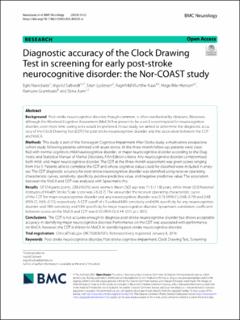| dc.description.abstract | Background
Post-stroke neurocognitive disorder, though common, is often overlooked by clinicians. Moreover, although the Montreal Cognitive Assessment (MoCA) has proven to be a valid screening test for neurocognitive disorder, even more time saving tests would be preferred. In our study, we aimed to determine the diagnostic accuracy of the Clock Drawing Test (CDT) for post-stroke neurocognitive disorder and the association between the CDT and MoCA.
Methods
This study is part of the Norwegian Cognitive Impairment After Stroke study, a multicentre prospective cohort study following patients admitted with acute stroke. At the three-month follow-up, patients were classified with normal cognition, mild neurocognitive disorder, or major neurocognitive disorder according to the Diagnostic and Statistical Manual of Mental Disorders, Fifth Edition criteria. Any neurocognitive disorder compromised both mild- and major neurocognitive disorder. The CDT at the three-month assessment was given scores ranging from 0 to 5. Patients able to complete the CDT and whose cognitive status could be classified were included in analyses. The CDT diagnostic accuracy for post-stroke neurocognitive disorder was identified using receiver operating characteristic curves, sensitivity, specificity, positive predictive value, and negative predictive value. The association between the MoCA and CDT was analysed with Spearman’s rho.
Results
Of 554 participants, 238 (43.0%) were women. Mean (SD) age was 71.5 (11.8) years, while mean (SD) National Institutes of Health Stroke Scale score was 2.6 (3.7). The area under the receiver operating characteristic curve of the CDT for major neurocognitive disorder and any neurocognitive disorder was 0.73 (95% CI, 0.68–0.79) and 0.68 (95% CI, 0.63–0.72), respectively. A CDT cutoff of < 5 yielded 68% sensitivity and 60% specificity for any neurocognitive disorder and 78% sensitivity and 53% specificity for major neurocognitive disorder. Spearman’s correlation coefficient between scores on the MoCA and CDT was 0.50 (95% CI, 0.44–0.57, p < .001).
Conclusions
The CDT is not accurate enough to diagnose post-stroke neurocognitive disorder but shows acceptable accuracy in identifying major neurocognitive disorder. Performance on the CDT was associated with performance on MoCA; however, the CDT is inferior to MoCA in identifying post-stroke neurocognitive disorder. | en_US |

